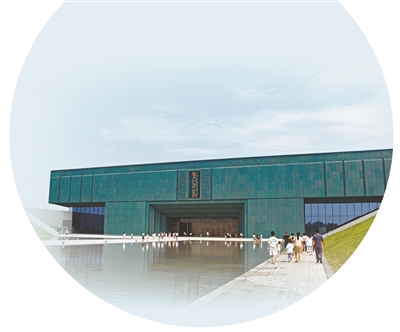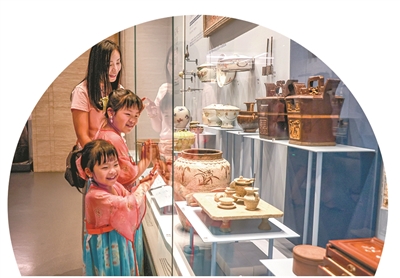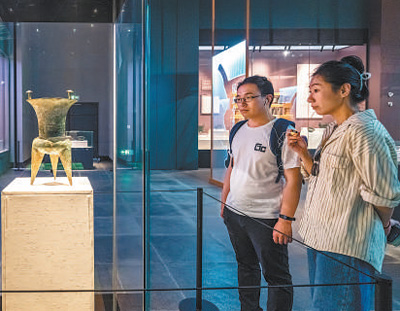China's museum sector sees rapid growth
From:People's Daily OnlineAuthor: 2025-05-26 16:00

Photo shows Yinxu Museum's new building in Anyang, central China's Henan Province. (Photo/Li Xianjun)
China's museum sector is growing rapidly, fueled by more museums, better exhibits, new technology and improved services.
According to the latest data from the National Cultural Heritage Administration (NCHA), the number of museums in China has increased by more than 200 each year over the past decade.
By the end of last year, the country had 7,046 museums, with 91.46 percent offering free admission. In 2024, museums across China hosted 43,000 exhibitions and welcomed 1.49 billion visitors.
New museums are offering visitors fresh and distinctive experiences. Qinling Museum, located in Shangluo in the heart of the Qinling Mountains in northwest China's Shaanxi Province, opened to the public this year. As China's first comprehensive museum dedicated to the ecology and culture of the Qinling Mountains, it is notable for its striking architecture, which was inspired by a national first-class artifact — a jade ceremonial blade from the Xia Dynasty (2070-1600 B.C.).
Qinling Museum also serves as a venue for performances and leisure activities. After nightfall, its "jade blade" structure becomes a canvas for light shows, further enhancing the visitor experience.

Visitors view exhibits at the China Grand Canal Museum in Yangzhou, east China's Jiangsu Province, May 17, 2025. (Photo/Ren Fei)
The opening of new museum branches is boosting growth and attracting more visitors to the sector. Shanghai Museum East, an extension of the renowned Shanghai Museum that opened last year, has quickly become a cultural magnet. The facility features 20 exhibition halls and interactive experience spaces across more than 110,000 square meters.
Highlights on display include bronze ritual vessels from the Shang and Zhou dynasties (1600-256 B.C.), masterpieces of calligraphy and painting fromthe Tang Dynasty (618-907), and the Song Dynasty (960-1279), and jade carvings from the Ming and Qing dynasties (1368-1911). Science-based exhibition design brings these treasures of Chinese civilization to life, vividly presenting the depth of the country's history and culture.
Thanks to its spacious layout, which helps prevent crowding, Shanghai Museum East does not require advance reservations. Even during peak times, visitors can enjoy the exhibits at their own pace.
"Chinese and international tourists are eager to visit our exhibitions," said Chen Jie, deputy curator of Shanghai Museum. "We hope Shanghai Museum can serve as a window for the world to see China."
By the end of last year, the total floor area of museums across China had surpassed 43.92 million square meters, collectively housing 67.4 million artifacts.
The NCHA has actively promoted the development of smart museums and cultural relics databases, accelerating digitization and expanding data resources.
With the help of new technology, the Suzhou Bay Museum in Suzhou, east China's Jiangsu Province, has brought new life to ancient artifacts.
The museum saw large crowds during the May Day holiday, thanks to an interactive event. In the 5G Grand Canal immersive experience zone, visitors used naked-eye 3D technology to virtually ride a northbound transport vessel and view panoramic scenes along the canal. With virtual reality headsets, guests could also tour digital exhibition halls and view nearly 30 featured exhibits.
"Digital innovation makes the audience's journey into cultural heritage more fascinating," said Ru Yuelai, curator of the Suzhou Bay Museum.
New technology is enabling museums to tell the stories of relics and preserve historical culture in more creative ways, making artifacts and exhibits more vivid and engaging for visitors.

Visitors view an exhibit at Suzhou Bay Museum in Suzhou, east China's Jiangsu Province. (Photo/Zhang Feng)
At Yinxu Museum's new building in Anyang, central China's Henan Province, innovative exhibition methods bring the civilization of the Shang Dynasty (1600-1046 B.C.) to life. Among nearly 4,000 artifacts on display, about three-quarters are being shown publicly for the first time.
Zhao Qingrong, executive deputy curator of Yinxu Museum, said the team uses digital restoration technology to recreate scenes from aristocratic life in the Shang Dynasty.
The museum employs holographic projections to illustrate bronze-casting and oracle bone divination — an early Chinese method of seeking guidance by interpreting cracks in heated animal bones or shells. The curators also bring ancient oracle bone script to life with digital technology, making the characters appear to speak.
"These creative and vivid presentations have been widely praised," said Zhao.
Yueju Museum, China’s first museum dedicated entirely to opera, officially opened its new building in 2023 in Shengzhou, east China's Zhejiang Province — the birthplace of female Yue Opera.
"The new building covers more than 18,000 square meters and houses over 30,000 Yue Opera artifacts and historical materials," said Yu Wei, curator of the museum.
Yu added that the museum's extensive collections, quality educational platforms and rich opera resources help preserve and promote traditional Chinese culture.
At the new building, visitors can explore the culture and history of Yue Opera, watch live performances of selected excerpts, try on costumes and even step on stage for photos, immersing themselves in the charm of this unique art form.
Edit:董麗娜
The copyright of the article and the picture belongs to the original author. If there is any infringement, please contact to delete it